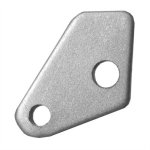re:
In a civil litigation, it wouldn't matter. All that would matter is that you deactivated a designed-in safety device, and would be used to show reckless disregard.
There is no hammer lock. The manual safety doesn't lock or block the hammer. If the sear were to suddenly disintegrate into dust, the hammer will fall, and it'll wipe the thumb safety off faster than you can do it with your thumb. Bang. It's fortunate that this isn't likely to happen.
The US military never issued a Series 70 pistol.
That said, I'm not a fan of Series 80 "Lawyer" parts. I much prefer the original design, and all my carry pistols are of that design...even though I've never had a single problem with any of the numerous intact Series 80 pistols that I've owned.
I removed the parts from my beaters for one reason. I shoot a lot, and 99.9% of my ammunition is handloaded with my home-cast bullets and soft lube. Nasty stuff that requires fairly frequent detail stripping...about every 2000-2500 rounds...and I got tired of fiddling with the extra parts. The spacer simplifies the process and saves time, which is at a premium for me.
The removal of the plunger and tiny spring in the slide eliminates the possibility of losing one or the other. With my aging eyes, the probability of finding the spring is nearly zip. Even though I know how to remove it with minimal risk of loss...Murphy is alive and well, and he never sleeps.
It is not a safety device, it's an idocracy invented to make some queer lawyer happy or maybe as a marketing strategy to sell more guns as 'new and improved'.
In a civil litigation, it wouldn't matter. All that would matter is that you deactivated a designed-in safety device, and would be used to show reckless disregard.
There are already three safety devices on a series 70: The hammer and slide lock, the grip/trigger lock, and of course the trigger itself
There is no hammer lock. The manual safety doesn't lock or block the hammer. If the sear were to suddenly disintegrate into dust, the hammer will fall, and it'll wipe the thumb safety off faster than you can do it with your thumb. Bang. It's fortunate that this isn't likely to happen.
The US military used the series 70 for how many years?
The US military never issued a Series 70 pistol.
That said, I'm not a fan of Series 80 "Lawyer" parts. I much prefer the original design, and all my carry pistols are of that design...even though I've never had a single problem with any of the numerous intact Series 80 pistols that I've owned.
I removed the parts from my beaters for one reason. I shoot a lot, and 99.9% of my ammunition is handloaded with my home-cast bullets and soft lube. Nasty stuff that requires fairly frequent detail stripping...about every 2000-2500 rounds...and I got tired of fiddling with the extra parts. The spacer simplifies the process and saves time, which is at a premium for me.
The removal of the plunger and tiny spring in the slide eliminates the possibility of losing one or the other. With my aging eyes, the probability of finding the spring is nearly zip. Even though I know how to remove it with minimal risk of loss...Murphy is alive and well, and he never sleeps.
Last edited:

